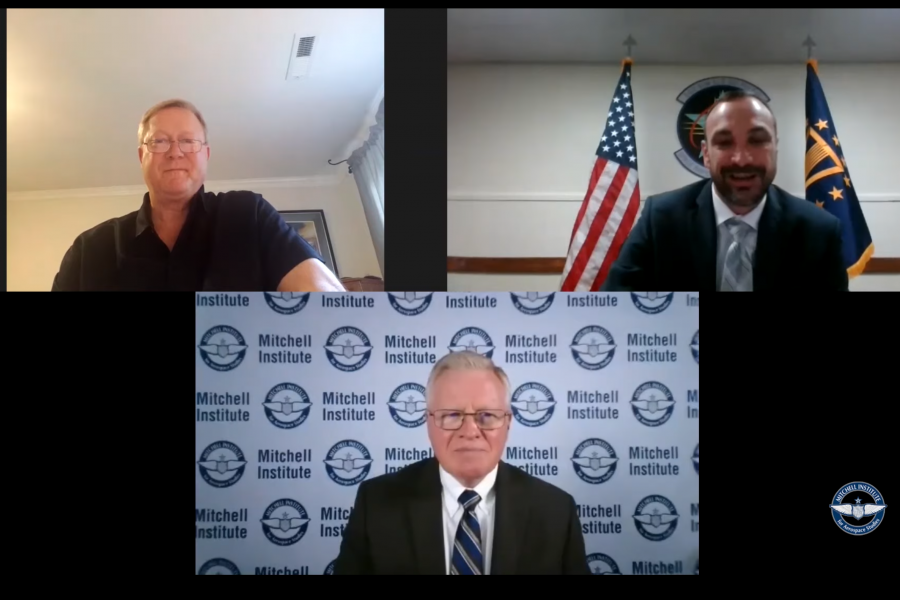The secretive Space Rapid Capabilities Office’s workload has taken shape two years after its inception, as the space research and development enterprise changes around it.
The Space RCO, which speedily develops cutting-edge technologies at the request of Space Force Chief of Space Operations Gen. John W. “Jay” Raymond, handles capabilities that go “in, from, and to space,” with less bureaucracy and more flexibility than typical research programs, Space RCO Director Michael W. Roberts said during a virtual Aug. 13 Mitchell Institute for Aerospace Studies event.
“That may sound familiar, as the U.S. Space Force thought about what we go after,” Roberts said. “I don’t see that changing. … There’s a lot of different capabilities that we’re working right now, and in the future, I see that staying about the same number.”
Randall G. Walden, head of the separate Air Force Rapid Capabilities Office, indicated in 2018 the new group needed to set a baseline from which to start its work.
“To me, that’s the most important piece,” Walden said. “Once you get a feel for the space system you want to go build, then you can start populating with the right folks and get the right contracting officers and program managers.”
The Space RCO appears to have settled on a slate of initiatives that will keep it occupied. Most of its portfolio is classified, but ostensibly complements work underway at the Space Force’s more traditional Space and Missile Systems Center and the commercial industry-focused Space Development Agency.
A space solar power program that fell under the former Operationally Responsive Space office is transitioning to the Air Force Research Laboratory instead. The Space RCO replaced the ORS office at Congress’ direction.
One program that looks to augment existing spacecraft ground control systems isn’t quite as under wraps.
“We’re working at it as a rapid acquisition program to build some algorithms to help with ground processing,” Roberts said.
However, one project will notably stay off the Space RCO’s plate: the experimental X-37B spaceplane. It is a reusable, uncrewed spacecraft that carries experiments to orbit, then returns them to Earth for evaluation. After spending a record-breaking 780 days on orbit, the Boeing system is receiving the National Aeronautic Association’s prestigious Robert J. Collier Trophy for furthering aerospace technology.
Walden said the Air Force RCO will keep the Orbital Test Vehicle in its own portfolio but will continue to collaborate with the Space RCO.
“I’ve talked to Gen. Raymond about that multiple times, and the Secretary of the Air Force,” Walden said. “We plan on keeping that. There’s a lot of interest in reusable space vehicles, and right now, we’ve gained a lot of information in the decade we’ve been operating that system.”
The Air Force and Space RCOs will work together as the X-37B offers more insight into new technologies that could shape future space systems. Roberts’s team could ask the Air Force RCO to test payloads on the spaceplane that would eventually fly on satellites or other spacecraft.
Critics argue that defeats the purpose of creating an RCO specifically to handle space projects, echoing larger concerns that the fragmented military space enterprise is simply growing instead of consolidating into something more effective.
The Space RCO sees itself as a fast-moving counterpart to the SMC, which handles more traditional military satellites, radars, and other space-related equipment from design to retirement. It is also supposed to mirror certain efforts at the SDA, which now reports to the Pentagon’s research and engineering boss but will transfer to the Space Force in the next few years. The Defense Advanced Research Projects Agency handles similar initiatives that can transition to the Space RCO as well.
Roberts and SDA Director Derek M. Tournear talk at least once a week about their similar efforts. SDA is pursuing a constellation of potentially thousands of satellites in low Earth orbit to handle everything from target tracking to missile warning.
“[Our approach] is a little bit different,” Roberts said. “He has an ability to go out and do proliferated things, using straight off-the-shelf things that commercial [industry] is doing, for the most part. We don’t necessarily have that same construct.”
He firmly opposes the prospect of moving under the Space Force’s new Space Systems Command, the organization meant to encompass all space research, development, and acquisition under the Department of the Air Force. Right now, the plan is to continue answering directly to Raymond.
“If we move under the Space Systems Command, we probably should cease to exist,” Roberts said. “It will slow us down. It’s not the fault of … the commander or anybody else at Space Systems Command, it’s just because you’re adding two to three layers of bureaucracy and decision-making on top of my current organization. You will never be allowed to go fast.”
